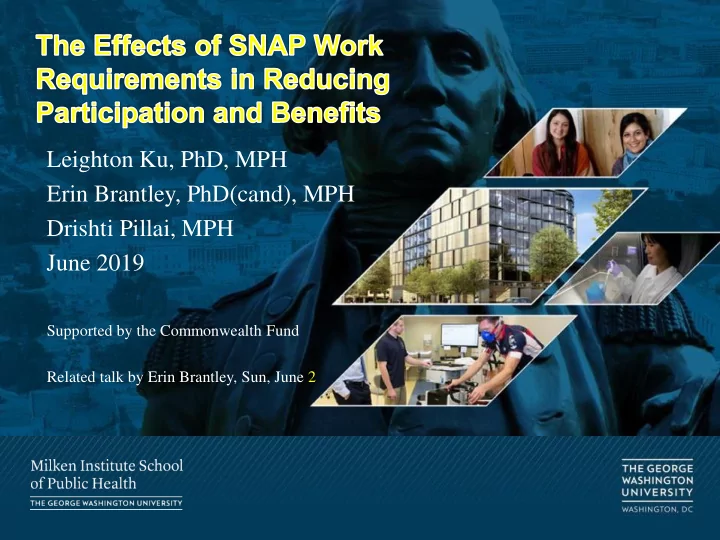

Leighton Ku, PhD, MPH Erin Brantley, PhD(cand), MPH Drishti Pillai, MPH June 2019 Supported by the Commonwealth Fund Related talk by Erin Brantley, Sun, June 2
Work Requirements & Public Benefits • Work requirements and welfare-to-work: a major policy theme in 1990s welfare reform. Back again. • President proposing more work requirements in welfare, SNAP. Also in Medicaid and public housing. • In SNAP, currently applies to 18-49 year old Able Bodied Adults Without Dependents (ABAWDs). States may seek waivers due to high unemployment. Waivers falling. • FNS proposing to limit waivers through regulations. Could end SNAP for 750,000 adults. Also budget proposals. • CMS promoted work requirements thru Medicaid waivers. Approved 9 and many more pending. Challenged in court.
Purpose of Work Requirements? • Claim that work requirements promote employment & economic mobility. Unemployment very low right now. • CMS has claimed employment leads to better health. • Many believe work shows “worthiness.” C oncerned about people getting something for nothing. • Public opinion depends on framing: – OK to require SNAP/Medicaid participants to work? vs – OK to take away SNAP/Medicaid if don’t work enough? • May be just be a way to cut SNAP and undercut Medicaid expansion. • But the cuts can create harm and hardship.
SNAP Work Requirement • 18-49 year olds ABAWDs must work at least 80 hours per month. Otherwise, only get SNAP 3 months out of 36. • Exempt if: has a dependent child, medically unfit to work or half-time student. Does not apply to those 50 or older. • States may waive work requirement due to high unemployment. May also exempt up to 15% (rarely used). • Similar policies imposed in Medicaid. Sometimes expand age range, include parents, exclude pregnant women, increase work hours, impose different lockout periods.
Why Study the SNAP Experience? • SNAP is major benefit program. Changes to SNAP affect food and economic security, as well as health. • Very little experience in Medicaid. In only case, Arkansas 18,000 lost coverage before being halted. • SNAP serves as a multi-year natural experiment, as work requirement waivers changed. • SNAP eligibility similar to Medicaid. SNAP 100%-130% FPL vs 138% FPL Medicaid expansion. • SNAP is best current model for rigorous evaluation of work requirements, even for Medicaid or public housing.
Data and Methods • Administrative data on SNAP caseloads and benefits by county every January and July 2012-17 from FNS. • Data from FNS about ABAWD waivers by area. Focus on county level changes. • Data from 2,410 counties from 2012-17 • Outcome: Δ ln(SNAP caseloads and benefits) over 2013-17 period. • Control for work requirements, lagged unemployment, poverty rate, state Medicaid expansion • Two way fixed effects models, controlling for county and period invariant effects. Weighted, adjusted for state clustering.
Percent of SNAP Participants Living in Counties with Work Requirements, 2013 to 2017 70% 60% 50% 40% 30% 20% 10% 0% Jan 13 Jul 13 Jan 14 Jul 14 Jan 15 Jul 15 Jan 16 Jul 16 Jan 17 Jul 17
Average County SNAP Caseloads, 2013 to 2017 17,000 15,000 Participants 13,000 11,000 9,000 7,000 Households 5,000 Jan 13 Jul 13 Jan 14 Jul 14 Jan 15 Jul 15 Jan 16 Jul 16 Jan 17 Jul 17
Key Results: % Change in Outcome Over Prior 6 Months, 2013-17 Participants Households Benefit $ Work Requirements -.030*** -.045*** -.038*** Lagged Unemp Rate .011*** .012*** .011** Poverty Rate .000 -.001 .000 Medicaid Expansion .016 .003 .015 N = 21,690 semiannual county observations ** p < .01, ***p<0.01
National Impact Estimates • Share of SNAP participants who are ABAWDs about 8.2% to 8.8%. ABAWDs particularly poor. • Thus, effect of 3% total loss implies more than one-third of ABAWDs lost benefits due to work requirements • Extrapolated to 2,410 counties: about 550,000 people lost SNAP benefits due to increase in work requirements from 2013 to 2017. Extrapolated to nation: about 600,000 loss. • $2.5 billion reduction in SNAP benefits in 2017. • Based on USDA fiscal multiplier study (2010) this would create $1.8 billion local economic loss and 8,900 fewer jobs.
Related Findings • Brantley, et al (2019) examined American Community Survey (ACS) data. • Also find work requirements lower participation. • Greater SNAP loss for African-Americans than whites. High losses for people with functional disabilities who are not on SSI. • The administrative data provide sharper estimates of the magnitude of effects because they measure participation better, but tell us little about who is affected. • ACS sheds light on distributional effects.
Public Health and Economic Effects • Loss of SNAP leads to food insecurity and material hardship. Unemployed ABAWDs among the poorest. • May also impair health and increase health care costs. • Recent research (Han 2018, Harris 2018) shows that SNAP work requirements lead to little or no increases in employment. • Consistent with prior research about TANF and work requirements. Work requirements also do not improve physical or mental health (Cochrane review 2018)
Discussion • 20 years of research show work requirements create substantial harm among eligible low-income people by reducing participation. • Evidence shows employment or income benefits are, at best, scant and fleeting. • Reductions in federal funding can lower economic growth and harm employment.
Conclusions • Work requirement policies are driven by ideology, not by evidence. • A rising economy naturally reduces demand and lowers caseloads. But a falling economy will reverse the trend. • To improve long-term opportunities for unemployed recipients, need better training, education and work supports (e.g., child care, transportation, health insurance). Need to address related social problems (incarceration, substance use), as well as strong economy.
Recommend
More recommend